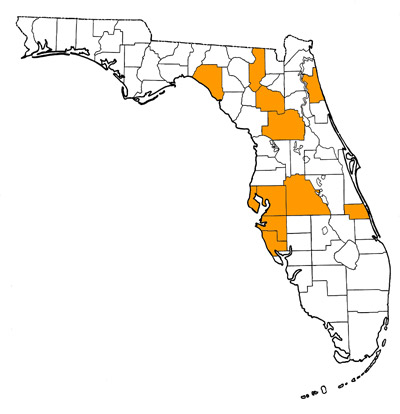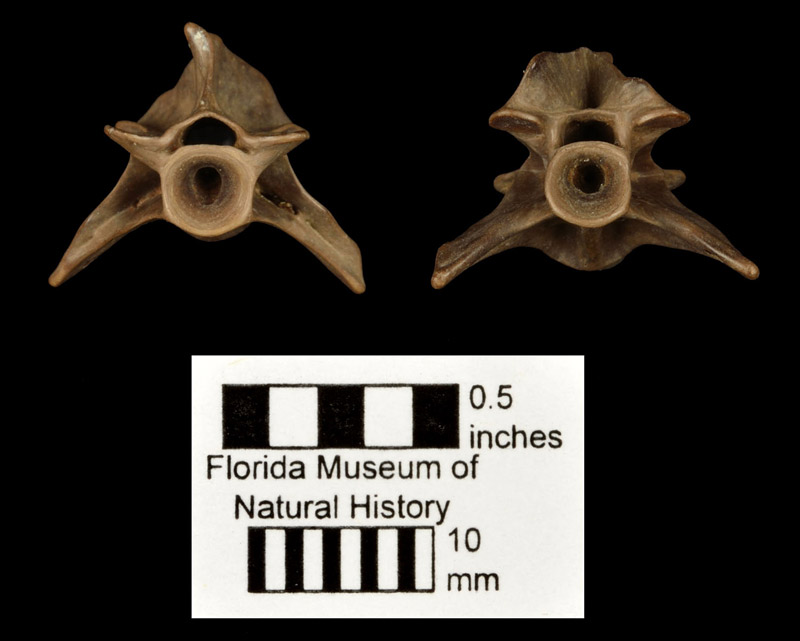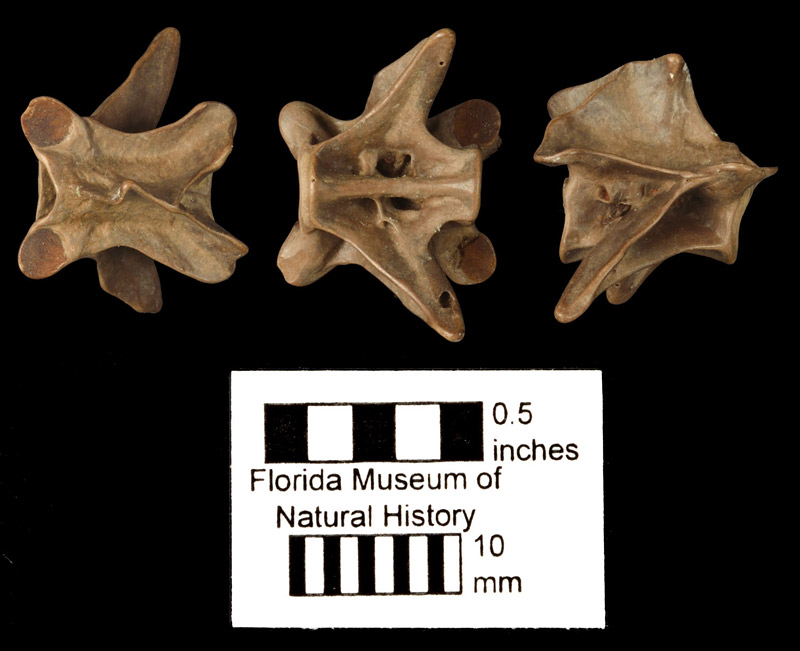Siren lacertina
Quick Facts
Common Name: greater siren
Siren lacertina is a large, extant salamander in the family Sirenidae that has been living relatively unchanged for 2.5 million years.
Alive, they are olive to light gray with elongate, snake-like bodies, short external gills, no hind limbs, and an average length of 20-30 in.
Most fossils of Siren lacertina have been found at sites with other aquatic vertebrates such as fish, frogs, or other aquatic salamanders, so presumably their ecologic preferences have remained constant over time.
Age Range
- Early Pleistocene to Holocene epochs; late Blancan land mammal age to present
- About 2.5 million years ago to the present
Scientific Name and Classification
Siren lacertina Österdam, 1766
Source of Species Name: the species name is derived from the Latin word lacerta, which means ‘lizard’.
Classification: Amphibia, Lissamphibia, Batrachia, Caudata, Urodela, Sirenidae
Alternate Scientific Name: none

Overall Geographic Range
Fossils identified as Siren lacertina have only been found in Florida (Harper, 1935; Goin and Auffenburg, 1959). However, living members of the species are found from southern Maryland through South Florida west to southern Alabama (Conant and Collins, 1998; Holman 2006).
Florida Fossil Occurrences
Florida fossil sites with Siren lacertina:
- Alachua County—Arredondo 2A; Haile 1A; Hornsby Springs
- Columbia County—Ichetucknee River; Santa Fe River 6
- Hillsborough County—Leisey Shell Pit 2
- Indian River County—Vero Canal Site
- Manatee County—Brandenton Field
- Marion County—Reddick 1B
- Palm Beach County—West Palm Beach Site
- Pinellas County—Maximo Moorings; St. Petersburg Times; Seminole Field; Zeta Pond Site
- Polk County—Palmetto Mine Pleistocene Bog
- Sarasota County—Macasphalt Shell Pit 1
- St. Johns County—Wilson Quarry
- Taylor County—Aucilla River 1A; Aucilla River 3J
Discussion
Siren lacertina is a large, extant salamander in the family Sirenidae. Live individuals may be recognized by their olive to light gray, elongate, snake-like bodies, short external gills, lack of hind limbs, and an average length of 20-30 in. or 51-76 cm, although the record length is about 98 cm (Conant and Collins, 1998). They are darker dorsally and have miniscule eyes, four fingers, and a variable number (31- 37) of costal grooves on their side (Cope, 1889). They closely resemble a second extant species of Siren, Siren intermedia, which is smaller in size (up to 68.6 cm) and has fewer costal grooves (Conan and Collins, 1998; Holman 2006). More information on the ecology and biology of living individuals can be found at the Animal Diversity web site.


Fossil specimens assigned to this species consist solely of vertebrae, which have amphicoelous centra (both ends of the vertebral body or centrum are concave), strong neural spines which are V-shaped when looked at from behind (Fig. 2), and with well-developed central keels with large foramina on either side (Meylan, 1995). They can be differentiated from the vertebrae of members of the closely related sirenid genus Pseudobranchus by looking at several other features of the zygopophyseal ridge and the vertebral body (Goin and Auffenburg, 1955). However, the identification of fossil sirenid vertebrae in Florida to Siren lacertina is almost entirely based on their large size. The vertebrae of Siren lacertina and Siren intermedia are practically identical except that the former is much larger (Goin and Auffenburg, 1955; Meylan 1995). Goin and Auffenburg (1955) attributed the large size of Siren lacertina to a trend generally seen in the Pleistocene of Florida where many groups of animals evolved forms much larger than their Miocene predecessors.
The oldest examples of fossils of Siren lacertina come from the late Blancan in the Macasphalt Shell Pit 1 (Sarasota County) and the St. Petersburg Times site (Pinellas County). The Leisey Shell Pit 2 record might be Irvingtonian, but that pit also commonly produced Rancholabrean specimens, and the specimen in question lacks stratigraphic data. All of the other Florida fossils sites with Siren lacertina are securely dated in the Rancholabrean land mammal age.
Most fossils of Siren lacertina have been found at sites with other aquatic vertebrates such as fish, frogs, or other aquatic salamanders. Presumably their ecologic preferences have remained constant over time, at least through the Pleistocene.
Sources
- Original Author(s): Arianna Harrington
- Original Completion Date: November 30, 2012
- Editor(s) Name(s): Richard C. Hulbert Jr. and Natali Valdes
- Last Updated On: March 11, 2015
This material is based upon work supported by the National Science Foundation under Grant Number CSBR 1203222, Jonathan Bloch, Principal Investigator. Any opinions, findings, and conclusions or recommendations expressed in this material are those of the author(s) and do not necessarily reflect the views of the National Science Foundation.
Copyright © Florida Museum of Natural History, University of Florida